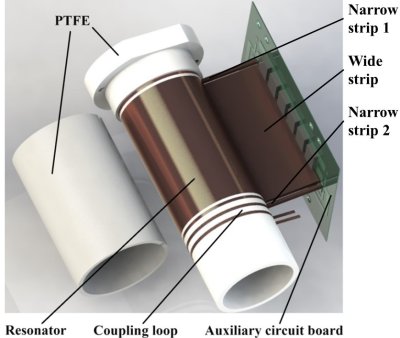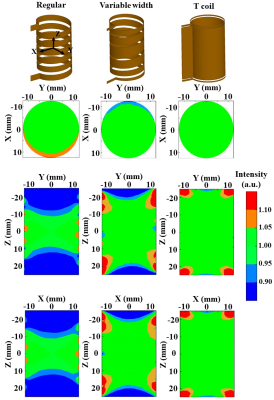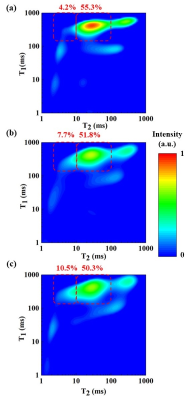1901
Optimized radio frequency coil for low-field magnetic resonance relaxometry in human finger1School of Mechanical Engineering, Southeast University, Nanjing, China, 2Department of Physics, University of Windsor, Windsor, ON, Canada
Synopsis
The permanent magnet based low-field and low-cost MR systems increase the accessibility and potential of point-of-care diagnosis, where relaxometry measurement is usually preformed due to the low requirement of B0 field homogeneity. However, inhomogeneous B1 field results in errors in the T2 relaxation times, especially in in-vivo localized human tissue measurements. A novel RF coil termed T coil has been developed to provide a better B1 field homogeneity and more accurate in-vivo relaxation measurements than the conventional coils. This may enable the noninvasive diagnosis of diseases through the human finger measurements with portable and affordable MR systems.
INTRODUCTION
Metabolic syndrome has affected human health seriously, with an increasing incidence rate1. Early detection and intervention are important to reduce the prevalence of metabolic diseases2-4. Low B0 field MR detection has become a popular research topic due to the low cost and portability. The permanent magnet based low field studies mainly focus on analyzing the T1 and/or T2 relaxation times, termed relaxometry5-6, to quantify the multiple microscopic components. In contrast to chemical shift spectroscopy, an accurate transverse relaxation experiment requires high quality 180° refocusing RF pulses for the entire effective volume. In the finite region, where B1 field transitions from the maximum value to zero, tissues experience nonideal refocusing pulses leading to errors in the measured T2 values, especially for the components with T1 much greater than T27. In this paper, the RF coil was optimized to provide a B1 field with improved homogeneity to increase the accuracy of multicomponent relaxation measurements.METHODS
T coil with improved B1 homogeneityAlternating current accumulates at the edge of the copper foil parallel to the direction of current flow, improving the uniformity of the B1 field. In this work, the loop-gap coil is modified with additional thin strips, termed T coil (Fig. 1), to further optimize current distribution and B1 field homogeneity. The finite element analysis method8-9 was employed to simulate the B1 field distributions. FID experiments with small flip angle were simulated (Python, ver. 3.7) and performed at 10MHz with a thin slice phantom to verify the B1 field distribution. The T coil was compared with a regular solenoid coil and a variable width coil, in all the simulations and MR experiments.
Phantom and in-vivo relaxation experiments
The complex human tissue is represented by a silicon rubber phantom, where multiple MR relaxation components exist due to its cross-linking states and different chain lengths. The CPMG signals were simulated with the Bloch equation. Relaxation experiments were performed on a thin slice phantom and a phantom similar to the size of a human thumb, to investigate the effects of B1 fields. The in-vivo 2D T1-T2 relaxation correlation experiments of human thumb were implemented with the T coil and conventional coils.
RESULTS
The simulated B1 field distribution of the conventional and T coils are shown in Fig.2. Superior B1 homogeneity was achieved with the proposed T coil. The B1 field distribution was validated with the FID simulations and experiments in Fig. 3.The inhomogeneous B1 fields led to non-ideal RF refocusing and large errors in the CPMG experiments for short T2 and long T1 components. The thin phantom experiments quantitively evaluated errors at different positions of the coils (results not shown). The large phantom had a reduced quantity of the fastest T2 component, most severe with the regular coil where the shortest T2 peak area was 32% lower than the true quantity (Fig.4). The T coil generated a T2 distribution closest to the true spectrum. The fastest relaxing peak area had a relatively low error of 8%. The in-vivo results agreed with that of the large silicon phantom (Fig. 5). The quantity of the shortest T2 component was largely underestimated with the regular coil and variable width coil.
DISCUSSION
The substances with weak spin-spin interactions, such as liquid molecules, generally have the same T1 as T2. The CPMG results are less affected by the RF pulse flip angle and B1 inhomogeneity. However, large errors may occur with and non-ideal refocusing, where the decay of transverse magnetization depends on both T1 and T27. The acquired effective T2 deviates from the true T2 value$$ 1/T2,eff = 1/T2-<nz2>(1/T2-1/T1) (1) $$
where <nz2> is a constant representing the degree of B1 field inhomogeneity. Amongst the three coils investigated in this work, the regular coil has the largest <nz2> value, and the T coil has the smallest <nz2> value. When the sample T1 is much larger than T2, the difference between the acquired effective T2 and the true T2 value is significant with a large <nz2>. The simulations and phantom experiments verified that the proposed T coil improved B1 field homogeneity and reduced T2 errors, which should lead to an increased MR detection accuracy of in-vivo finger measurements.
CONCLUSION
A novel coil structure termed T coil was developed in this work. The T coil provided better B1 field homogeneity than the conventional coils. The adverse effects of B1 field inhomogeneity on relaxation component analysis were validated by phantom relaxation experiments and in-vivo human finger experiments on a 10MHz permanent magnet system. The high B1 field homogeneity of the T coil improved the detection accuracy and may enable the noninvasive diagnosis of diseases through the finger measurements on low-field, low-cost and portable MR systems.Acknowledgements
The authors thank the financial supports from National Key Scientific Instrument and Equipment Development Project of China under Grant No. 51627808, National Natural Science Foundation of China under Grant No. 52075098 and Grant No. 51605089. D. X. thanks NSERC Canada for a Discovery Grant.References
1. S. M. Grundy, “Metabolic syndrome update,” Trends In Cardiovascular Medicine, vol. 26, no. 4, pp. 364-373, May, 2016.
2. Y. Xu, L. M. Wang, J. He, Y. F. Bi, M. Li, T. G. Wang, L. H. Wang, Y. Jiang, M. Dai, J. L. Lu, M. Xu, Y. C. Li, N. Hu, J. H. Li, S. Q. Mi, C. S. Chen, G. W. Li, Y. M. Mu, J. J. Zhao, L. Z. Kong, J. L. Chen, S. H. Lai, W. Q. Wang, W. H. Zhao, G. Ning, and C. N. D. Sur, “Prevalence and Control of Diabetes in Chinese Adults,” Jama-Journal Of the American Medical Association, vol. 310, no. 9, pp. 948-958, Sep 4, 2013. 3. M. Liu, S. W. Liu, L. J. Wang, Y. M. Bai, X. Y. Zeng, H. B. Guo, Y. N. Liu, Y. Y. Jiang, W. L. Dong, G. X. He, M. G. Zhou, and S. C. Yu, “Burden of diabetes, hyperglycaemia in China from to 2016: Findings from the 1990 to 2016, global burden of disease study,” Diabetes & Metabolism, vol. 45, no. 3, pp. 286-293, Jun, 2019.
4. A.I. Adler, “UKPDS - modelling of cardiovascular risk assessment and lifetime simulation of outcomes,” Diabetic Medicine, vol. 25, pp. 41-46, Aug, 2008.
5. D. S. Dudova, D. E. Protasov, and E. A. Protasov, “NMR Relaxometer-Spectrometer with Continuous Generation of the HF Field for Studying Biological Objects,” Applied Magnetic Resonance, vol. 44, no. 7, pp. 781-790, Jul, 2013.
6. D. P. Cistola, and M. D. Robinson, “Compact NMR relaxometry of human blood and blood components,” Trac-Trends In Analytical Chemistry, vol. 83, pp. 53-64, Oct, 2016.
7. M. D. Hurlimann, and D. D. Griffin, “Spin dynamics of Carr-Purcell-Meiboom-Gill-like sequences in grossly inhomogeneous B-0 and B-1 fields and application to NMR well logging,” Journal Of Magnetic Resonance, vol. 143, no. 1, pp. 120-135, Mar, 2000.
8. Mispelter J , Lupu M , Briguet A, "Homogeneous Resonators," in NMR Probeheads for Biophysical and Biomedical Experiments. 2006, pp. 467-600.
9. S. Z. Li, Q. X. Yang, and M. B. Smith, “Rf Coil Optimization - Evaluation Of B-1 Field Homogeneity Using Field Histograms And Finite-Element Calculations,” Magnetic Resonance Imaging, vol. 12, no. 7, pp. 1079-1087, 1994.
Figures




